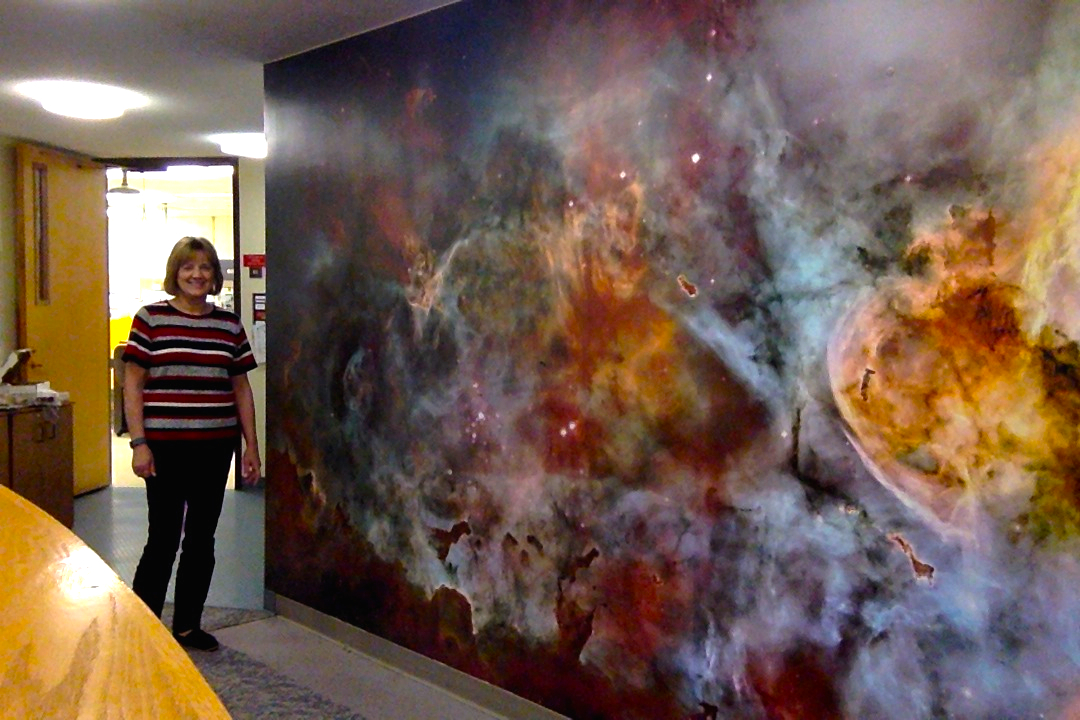Iterative Prototyping Design Strategy for the Facility Rotunda

One STEAM-relevant example of the MSU renovation planning now in progress centers on re-envisioning the rotunda of the St. Andrews facility, which was previously the principal home of the Boyer Library Collection for MMI. This is being undertaken via iterative prototyping, to assess how STEM-driven ideas can best be implemented within an ultimate design that is both STEAM-friendly and child-friendly.
For example, consider just a few of the learning opportunities, across multiple age levels, in the Carina Nebula mural now serving as rotunda re-purposing design prototype #1 (see photo, above, right).
- The region of space is 50 light-years left-to-right, 7500 light-years from Earth. It is easy to see math inquiries – ranging from the easy to the not-so-easy – for visiting K-12 investigators. How many inches on the wall per light-year? How many parsecs is it across? Might mural measurements with a “light-year ruler” or a “parsec stick” underestimate the true distances between Carina Nebula features? How many arc minutes will the nebula depicted in the mural cover in the sky?
- What was happening on earth when the light that made the mural picture left the Carina Nebula?
- The mural contains features called the Keyhole nebula and the Homunculus nebula. Can we find others and put up identifying Post-itTM arrows, with suggested names for them? What does the practice of giving such names to observational features tell us about ourselves as scientists?
- The very massive and very bright Eta Carina is nearing the cataclysmic end of its existence, but the mural also contains “stellar nurseries.” Some Carina Nebula stars are only about 500,000 years old. How long ago was their formation compared to the existence of Earth dinosaurs? Mammoths? Mastodons?
- Sometimes scientific data contain artifacts of our own observational techniques in addition to information about what we are studying. Can we find some artifacts on the wall? Younger students can find ruler-like markings (a “reticle”) centered on Eta Carina (Hmmm; why there?), and advanced students might note that the stars have Airy disks, to name two examples.
- If we get out the paint kits and design our own nebulas, what features might they realistically contain?
The Carina Nebula is the subject of a great deal of on-going research. See, for example this list of related stories on the NASA website.
MSU is seeking suggestions for other mural topics offering equivalent or superior opportunities for student hands-on learning and imaginative engagement. At the moment, rain forests, coral reefs, and the interior of macromolecules are under discussion. Other ideas are very welcome, and may be sent to Loraine J. Hudson, ljh@msu.edu.
Photo: A 15-ft.-wide mural of the Carina Nebula – The NASA image superimposes false-color gas features observed with the Hubble Space Telescope over a stellar field observed with the 4 meter Blanco Telescope at CTIO in Chile. Both observations were made by Nathan Smith, University of California / Berkeley.



